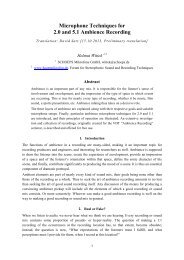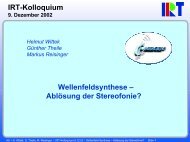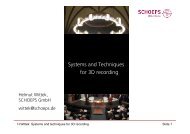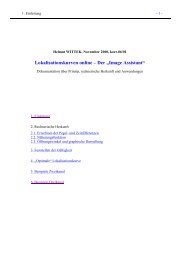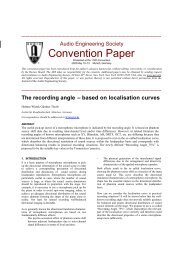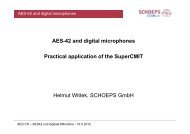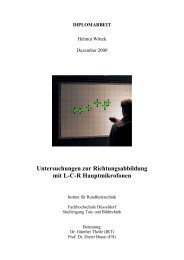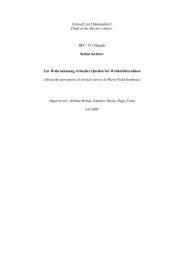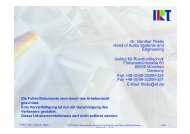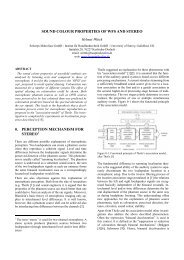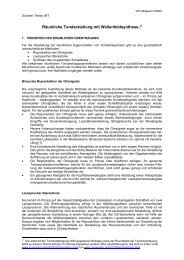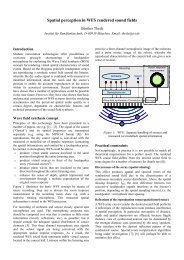on the localisation in the superimposed soundfield - Hauptmikrofon ...
on the localisation in the superimposed soundfield - Hauptmikrofon ...
on the localisation in the superimposed soundfield - Hauptmikrofon ...
You also want an ePaper? Increase the reach of your titles
YUMPU automatically turns print PDFs into web optimized ePapers that Google loves.
46<br />
For example, too small a time difference ∆t will result for a loudspeaker arrangement that<br />
is symmetrical with respect to <strong>the</strong> fr<strong>on</strong>tal plane (Figure 20, δ = 90°). The two maxima at<br />
each ear will appear at <strong>the</strong> same time; <strong>the</strong> localisati<strong>on</strong> stimuli are not discrim<strong>in</strong>able.<br />
C<strong>on</strong>sequently, <strong>the</strong>re will be no suppressi<strong>on</strong> of sound colourati<strong>on</strong>, which was c<strong>on</strong>firmed<br />
experimentally <strong>in</strong> Secti<strong>on</strong> 2.2.2 (Item 5, Figure 9b, Test signal A4). Fur<strong>the</strong>rmore, from<br />
Figure 9b it can be seen that <strong>the</strong> perceptibility of sound colourati<strong>on</strong> <strong>in</strong>creases as δ 90°.<br />
This is <strong>in</strong> l<strong>in</strong>e with <strong>the</strong> decrease <strong>in</strong> ∆t that is evident from Figure 20.<br />
In THEILE / PLENGE 1977 phantom source directi<strong>on</strong> was <strong>in</strong>vestigated as a functi<strong>on</strong><br />
of δ. The results showed that:<br />
1. For δ = 90°, <strong>the</strong> auditory event is located ei<strong>the</strong>r at <strong>the</strong> fr<strong>on</strong>tal or <strong>the</strong> rear<br />
loudspeaker, depend<strong>in</strong>g <strong>on</strong> <strong>the</strong> level ratio of <strong>the</strong> loudspeaker signals. In pr<strong>in</strong>ciple,<br />
lateral phantom sources do not arise. This is expla<strong>in</strong>ed by <strong>the</strong> localisati<strong>on</strong> model if<br />
<strong>on</strong>e assumes that for equal signal levels <strong>the</strong> localisati<strong>on</strong> stimuli cannot be<br />
discrim<strong>in</strong>ated due to identical <strong>in</strong>teraural time differences, but that for unequal<br />
levels <strong>on</strong>e or <strong>the</strong> o<strong>the</strong>r spectrum will dom<strong>in</strong>ate.<br />
2. The focus of <strong>the</strong> phantom source greatly decreases for δ > 60°. The time<br />
differences between <strong>the</strong> <strong>superimposed</strong> signals are of <strong>the</strong> magnitude ∆t < 200 µs<br />
(see Figure 20). It seems that this is where <strong>the</strong> discrim<strong>in</strong>ati<strong>on</strong> threshold of <strong>the</strong><br />
localisati<strong>on</strong> stimuli lies.<br />
3. As δ 90°, <strong>the</strong> directi<strong>on</strong> of <strong>the</strong> phantom source does not rema<strong>in</strong> <strong>in</strong> <strong>the</strong> centre of<br />
<strong>the</strong> loudspeaker base, but shifts by maximally 10° <strong>in</strong> <strong>the</strong> directi<strong>on</strong> of ϕ = 0°. This<br />
effect is <strong>in</strong> agreement with <strong>the</strong> fact that for a laterally displaced loudspeaker base<br />
<strong>the</strong> localisati<strong>on</strong> stimuli will not be simultaneously available. Of course, a<br />
localisati<strong>on</strong> stimulus can <strong>on</strong>ly be discrim<strong>in</strong>ated if it is available <strong>in</strong> b<strong>in</strong>aural form.<br />
This will happen later for <strong>the</strong> signal radiated by <strong>the</strong> loudspeaker closer to <strong>the</strong><br />
fr<strong>on</strong>tal plane (Signal B <strong>in</strong> Figure 20). Thus, <strong>the</strong> model expla<strong>in</strong>s <strong>the</strong> displacement<br />
from <strong>the</strong> centre of <strong>the</strong> loudspeaker base by means of a time difference between <strong>the</strong><br />
localisati<strong>on</strong> stimuli. This time difference will have a maximum value of about 200<br />
µs, which, accord<strong>in</strong>g to measurements made by WENDT 1963, corresp<strong>on</strong>ds to a<br />
change of ϕ = 10° … 15° <strong>in</strong> phantom source directi<strong>on</strong> (see Secti<strong>on</strong> 4.3.1).<br />
4.2.4 Auditory events <strong>in</strong> <strong>the</strong> case of narrow-band signals<br />
The associati<strong>on</strong> model is based <strong>on</strong> a pattern recogniti<strong>on</strong> process that is made possible<br />
by associative stimulus process<strong>in</strong>g. The localisati<strong>on</strong> process thus requires a sound<br />
source that allows for a sufficiently robust distance percepti<strong>on</strong> (see Secti<strong>on</strong> 3.2.1).<br />
This is <strong>the</strong> case if spectral characteristics of a current stimulus can be analysed.<br />
Associative stimulus process<strong>in</strong>g necessitates a sufficiently broadband stimulus.



